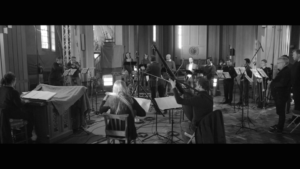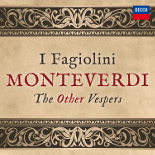Robert Hollingworth on performance practice issues – some new, some recycled, some just worth stating again.
Pitch & Vocal Layout
Monteverdi’s four voice types (the four standard Renaissance voice types) seem to have been:
- Top voice – boy, soprano, falsettist (countertenors) or castrato.
- Alto – not a countertenor but a light high tenor. F below middle C to the A above it. (At modern pitch, female altos and falsettists find this very low.)
- Tenor – the normal adult male voice. Baritenor is a good term. Average parts in standard Renaissance polyphony cover the C below middle C to the F above it.
- Bass – a bottom F to middle C. Monteverdi writes extensions at both ends.
Of course the actual pitch these would have been singing at in a particular centre would have varied but probably not by very much, given the physical limitations of voices.
In recent times, the research done on north Italian pitch in the early 17th century has encouraged many to perform this music at A466, a semitone higher than modern pitch. This means that the already rare species of high light modern tenor has to cope with singing even higher which can cause strain, positively discouraged in singing at the time. An alternative is to use falsettists (countertenors) on the ‘alto’ line but then you are re-voicing your vocal group away from Renaissance voice types. This matters particularly for the alto line that is often in the same range as and needs a similar range to the tenor.
So we have used A440 for this recording (a quite possible pitch for parts of northern Italy at the time) and kept high tenors on the alto line.
Solo-voice ensemble
The division of the 1610 Vespers psalm settings we all know and love into solo and choral passages is a perfectly reasonable modern performance decision for modern choirs. It doesn’t stem from any indications in the written music though: such complex polyphony would probably have been intended for a solo-voice ensemble. The same is the case for the settings from 1641 Selva Morale e spirituale we perform here.
This would not need to be the case for Monteverdi’s Mass setting from 1610 designated on the title page ‘for church choirs’ (though that could also easily be sung by six voices). There are other vocally simpler pieces of polyphony in 1641 which suit choral performance much better.
Instrumentation
1) The index page to the partbooks of some of the Vesper psalms in 1641 include the suggestion to double some of the parts on viols or trombones. In larger venues especially, it makes sense to strengthen the lower parts in this way, which is what we will be doing in the concerts. Elsewhere as we had the players on hand, we have doubled all the vocal parts with cornetts and trombones at particular moments of emphasis, otherwise allowing the voices to carry the character of the line on their own.
2) Palestrina/Bovicelli: ‘Ave verum corpus’
This piece started out as a 5-voice madrigal by Palestrina, his ‘Io son ferito, ahi lasso’ published in 1561. In 1594 Bovicelli published two different ornamented versions of the top line. To one of them he changed the text from ‘Io son ferito’ to the sacred ‘Ave verum corpus’. We then underlayed the whole of the original madrigal with that sacred text and have the ornamented part played on a cornetto muto by Gawain Glenton.
Time changes
Aside from the question of the speed you want to take a piece (dependent on numbers performing, acoustic and other factors), in music of the Renaissance/early Baroque there is the issue of what to do at time changes from duple into triple and back again. The uncertainty is based on the fact that the signs used to indicate the duple or triple time can also have a meaning tying the relationship of the number of duple beats to the number of triple beats in some form of triplet: 3 in the time of 2 (referred to at the time as ‘sesquialtera’) or 3 in the time of 1 (‘tripla’). Over 20 years ago, Roger Bowers wrote a closely argued article defending a literal reading of these signs, at least as far as what Monteverdi might have meant by then (without suggesting that modern performers were de facto obliged to follow them). Others argued against this, claiming that the system was in disarray by then. I’ve spent nearly 30 years playing with different options but also looking at original time signatures in an attempt to see what real differences there are. This is not the place for a full article (which may or may not follow…) but:
Most modern recordings work at a much faster triple speed (6 in the time of 1 – see note 5 below). My conclusion is that tripla (3 semibreves in the time of 1 duple semibreve) was the most common change, and applying this leads to a slower triple and a slightly faster duple than we’re used to hearing.
Some of the reasons for this are:
- Monteverdi was brought up in a church music (i.e. conservative) musical background in the 1570s. There’s every reason why he would have been taught to respect traditional music mensuration signs (which are a medieval concept) and their meaning.
- Whether these are 3 in the time of 1, or 3 in the time of 2, you end up with a slower triple time than is generally heard today.
- Standard Renaissance and Monteverdi triple time notation is mostly three semibreves per pulse. There are different ways of notating the ‘time signature’ for this but the most common one literally means 3 in the time of 1 duple semibreve (tripla). It’s surely worth starting with this concept and seeing where it takes us. (There are two works of Giovanni Gabrieli that require the duple and triple at the same time, in which exactly this time relationship is kept.)
- The 1641 volume was put together very late in Monteverdi’s life and is full of errors/inconsistencies. John Whenham has written conclusively about how the publication was prepared in two parts, one prepared considerably in advance by the printer (in 1640) and another part arriving late (in 1641). As far as time signatures are concerned, it’s notable that the inconsistencies are all in the part of the collection that the printer had for a long time and may have reset (inconsistently) in line with what he expected modern readers to expect (3/2 instead of 3/1 was being used as a time signature by younger composers by that time, without any apparent difference in meaning) whereas the music that arrived last – and therefore is presumably the newest and much more likely to be direct from the pen of Monteverdi – has none of these inconsistencies and all the old-style triple time indications implying 3 in the time of 1.
- The concept that Baroque music is related to the dance and should all trip along according to zappy late baroque dance rhythms is fine – for late Baroque music.
- There is an argument on a further level about whether one moves from the duple to the triple really in the manner of triplets (bar = bar, 3 in the time in 1) or with the smaller note values equalling each other. I’ll write about that at another time but even with duple crotchet = tripla semibreve, the triples are slower than is generally heard today.

